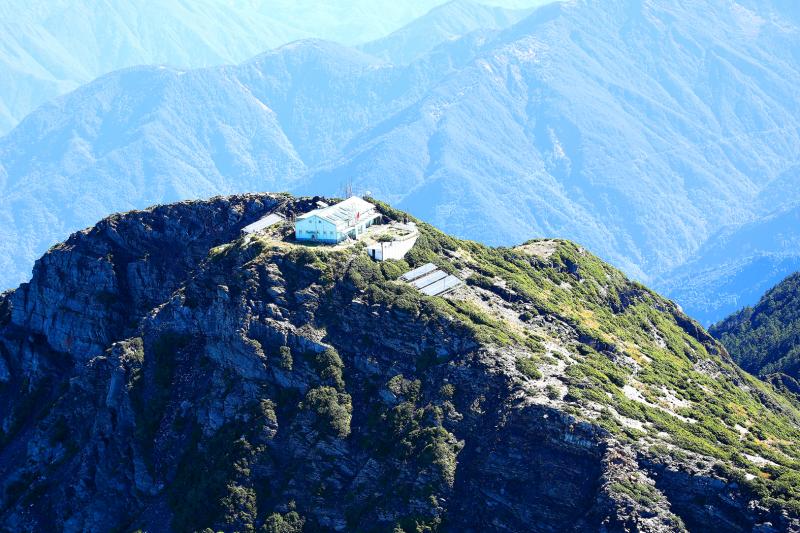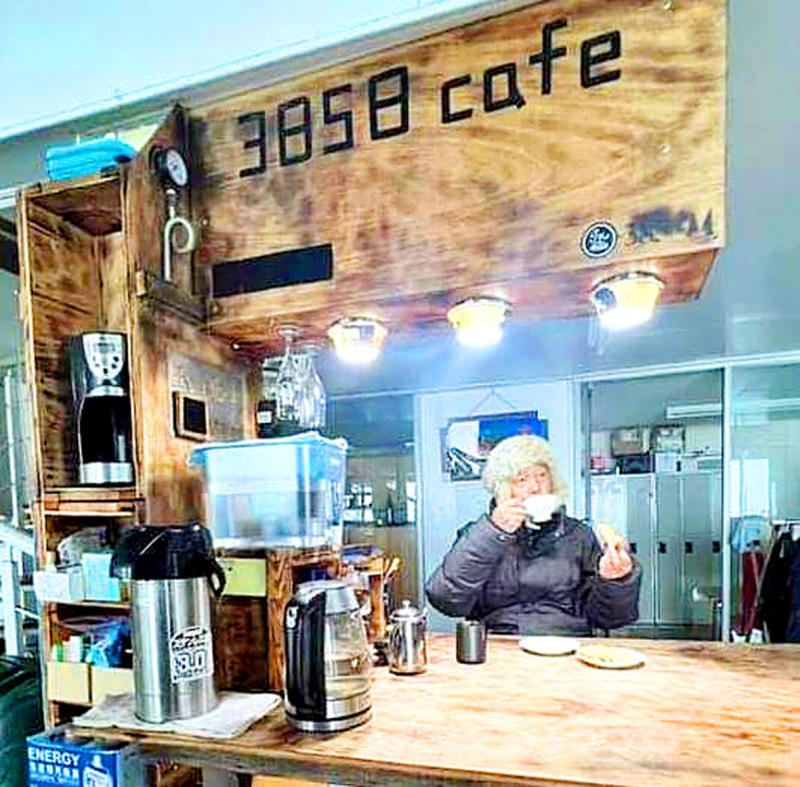Situated 3,858m above sea level, the Central Weather Bureau’s Yushan Weather Station has the twin distinctions of being the highest weather station in northeast Asia and the highest-altitude building in Taiwan. A hiker who recently climbed the north peak was both astonished and delighted to discover a small cafe called “3,858 Cafe” inside the weather station. After making enquiries, the hiker discovered that it was built from discarded materials by workers at the station.
Yushan Weather Station was constructed 78 years ago, in 1943. After the 921 Earthquake struck the nation on Sept. 21, 1999, major advanced earthquake detection equipment began to be installed at the station, followed by the installation of a satellite Internet connection, which greatly improved the problem of interrupted telecommunications signals to the station. In addition to monitoring alpine weather and providing real-time, accurate weather-related data, the station is also responsible for assisting with air search and rescue by providing cloud cover, visibility and other meteorological data.
An observer surnamed Hsieh who has worked at the station for more than two decades says that the harsh alpine climate, along with scarce water and a limited electricity supply, has imbued a spirit of “taking hardship in one’s stride” in fellow employees, and an ethos of persevering in the job. Hsieh says that wooden crates used to transport the electricity generators and large batteries required by the station, once dismantled, cannot be disposed of willy-nilly. They therefore got creative and pieced together the discarded materials to create a simple cafe, which has become a little paradise for colleagues when taking a break during gaps in their work, says Hsieh. An occasional cup of coffee accompanied by a cookie helps workers at the station to stay fresh and stave off hunger, while the improvised cafe not only helps to relieve stress, but has also eliminated the bother of lugging large pieces of waste material down the mountain, adds Hsieh.

Photo: Wikimedia Commons 照片:維基共享資源
Cafe 3,858 was completed a little over a month ago, and news of its existence quickly spread by word of mouth among Taiwan’s hiking community. It soon became an unusual photo op and social media “check in” location for hikers climbing Yushan’s north peak. With increasing numbers of hikers attracted to visit the cafe, staff at the weather station have announced that the high-altitude cafe is not open to the public. Use of the cafe is reserved for employees on account of the large amount of meteorological equipment installed at the station, and to provide a brief moment of bliss during their grueling sojourns at the isolated outpost. Staff say they hope that hikers will abide by the rule of “entry by invitation only” to avoid impacting on their work and to maintain cordial relations.
(Liberty Times, translated by Edward Jones)
位於海拔三千八百五十八公尺的中央氣象局玉山氣象站,不但是東北亞最高的氣象站,也是全台海拔最高的建築物,最近山友攀登至此,赫見氣象站內竟有一座「3858咖啡吧」,莫不覺得又驚又喜,進一步探詢,始知是氣象站工作人員利用廢棄材料打造而成的。

Photo courtesy of a member of the public 照片:民眾提供
玉山氣象站建於西元一九四三年,迄今已有七十八年歷史,一九九九年九二一大地震後,開始裝設高科技強震儀,之後又架設衛星網路,大幅改善訊號中斷問題,除了監測高山氣象並提供即時、準確的氣象相關資料以外,也肩負協助空難救援時的雲量及能見度等資訊。
在氣象站工作二十多年的謝姓觀測員表示,高山氣候嚴寒,且缺水又缺電,但站內同仁都秉持「吃苦當作吃補」的精神,堅守崗位,惟因氣象站所須的發電機、大型電池等木製包裝拆卸後,又不能隨意亂丟,同仁遂發揮創意,將廢棄材料東拼西湊打造出簡易的「咖啡吧」,也成為彼此工作空檔休息的小樂園,時不時喝個咖啡提神或吃個餅乾充飢,不但可達到紓壓效果,也免去大型廢棄物搬運下山處理的困擾。
在此前提下,氣象站人員配合海拔高度將咖啡吧取名叫作「3858咖啡吧」,完工迄今已一個多月,也意外成為山友拍照、打卡的熱點,且口耳相傳下,有愈來愈多的山友慕名而來,因此,氣象站人員特別聲明,站內有諸多氣象監測相關設施,此高山咖啡吧只提供氣象站員工本身「苦中作樂」的小確幸,並不對外營業,也希望山友能遵守「非請勿入」原則,避免影響氣象工作及和氣。
(自由時報謝介裕)

If you’ve recently spotted adults parading around with cuddly toys dangling from their designer handbags, your eyes haven’t been deceiving you. The playful trend of adorning bags with cute charms has become popular among people of various ages. Plushies like Labubu and anime and manga characters such as Chiikawa have become must-have accessories that make personal statements. The practice of attaching charms to personal items has been common across cultures throughout history. In ancient civilizations, charms were often used as symbols of protection, good luck, or identity. Fast-forward to more modern times, and style icons like Jane Birkin, a

★ Bilingual Story is a fictionalized account. 雙語故事部分內容純屬虛構。 Kevin leaned over the bubbling pot. “Hey. . . are you okay? You’ve barely touched your food.” Zoey blinked. Her face was red — not from blushing, but from the “mala” spice and the heat of the room. Her blond hair clumped to her face like strands of fine spaghetti. Her carefully applied makeup now streaked. “This isn’t what I expected,” she said softly, forcing a smile. All around them, Kevin’s friends were laughing, shouting, and tossing ingredients into the broth. The air smelled of chili oil and garlic.

A: Apart from Jin Yong, the late martial arts novelists Liang Yusheng and Gu Long were also very popular. B: Wasn’t Liang a pioneer of the “new school” wuxia genre in the 20th century? A: Yup, I really like his Tianshan mountain series. All the characters — such as the “White Haired Demoness” — are so vivid. B: The roles in Gu’s books are lively, too — like the “Fragrant Commander” Chu Liuxiang. A: And the TV drama adapted from the Chu Liuxiang series swept across Taiwan in the 1980s, with ratings surging over 70 percent at that time.

Continued from yesterday(延續自昨日) https://www.taipeitimes.com/News/lang If plushie charms are cute little nods to people’s interests, ita bags are full-on declarations. The term “ita” comes from the Japanese word itai, which means “painful” and reflects the overwhelming visual intensity of these bags. An ita bag is essentially a handbag, backpack, or tote meticulously decorated with an extensive collection of merchandise dedicated to a specific character or idol. These bags usually feature a clear plastic window to display carefully arranged pins, badges, keychains, or fan art. Both the interior and exterior may be covered in fandom memorabilia, creating an aesthetic so intense that it’s almost “painful”